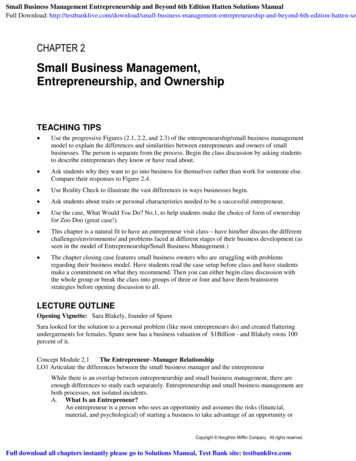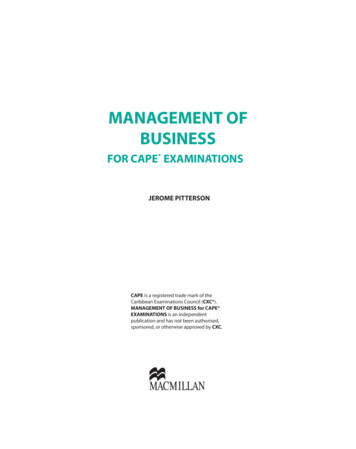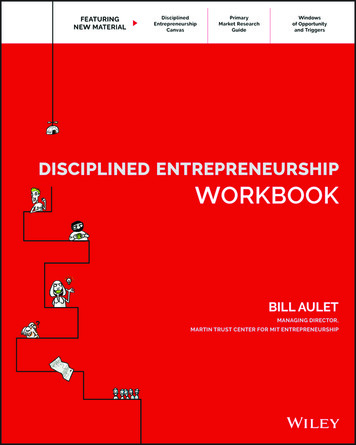
Transcription
Small Business Management Entrepreneurship and Beyond 6th Edition Hatten Solutions ManualFull Download: atten-soCHAPTER 2Small Business Management,Entrepreneurship, and OwnershipTEACHING TIPS Use the progressive Figures (2.1, 2.2, and 2.3) of the entrepreneurship/small business managementmodel to explain the differences and similarities between entrepreneurs and owners of smallbusinesses. The person is separate from the process. Begin the class discussion by asking studentsto describe entrepreneurs they know or have read about. Ask students why they want to go into business for themselves rather than work for someone else.Compare their responses to Figure 2.4. Use Reality Check to illustrate the vast differences in ways businesses begin. Ask students about traits or personal characteristics needed to be a successful entrepreneur. Use the case, What Would You Do? No.1, to help students make the choice of form of ownershipfor Zoo Doo (great case!). This chapter is a natural fit to have an entrepreneur visit class—have him/her discuss the differentchallenges/environments/ and problems faced at different stages of their business development (asseen in the model of Entrepreneurship/Small Business Management.) The chapter closing case features small business owners who are struggling with problemsregarding their business model. Have students read the case setup before class and have studentsmake a commitment on what they recommend. Then you can either begin class discussion withthe whole group or break the class into groups of three or four and have them brainstormstrategies before opening discussion to all.LECTURE OUTLINEOpening Vignette: Sara Blakely, founder of SpanxSara looked for the solution to a personal problem (like most entrepreneurs do) and created flatteringundergarments for females. Spanx now has a business valuation of 1Billion - and Blakely owns 100percent of it.Concept Module 2.1The Entrepreneur–Manager RelationshipLO1 Articulate the differences between the small business manager and the entrepreneurWhile there is an overlap between entrepreneurship and small business management, there areenough differences to study each separately. Entrepreneurship and small business management areboth processes, not isolated incidents.A. What Is an Entrepreneur?An entrepreneur is a person who sees an opportunity and assumes the risks (financial,material, and psychological) of starting a business to take advantage of an opportunity orCopyright Houghton Mifflin Company. All rights reserved.Full download all chapters instantly please go to Solutions Manual, Test Bank site: testbanklive.com
Chapter 2: Small Business Management, Entrepreneurship, and OwnershipB.9idea. Behaviors generally associated with entrepreneurship are creation of a business;innovation of a new product, process, market, material, or organization; risk assumption;general management of the business and its resources; and performance intention of profitand/or growth.Entrepreneurship and the Small Business ManagerEntrepreneurship involves the startup process. Small business management focuses onrunning a business over a long period of time.Entre-PerspectivesAre You Ready?The point of this quiz is to begin discussion by comparing students’ responses with responses ofentrepreneurs in general. The instrument used is not intended to be predictive of who will or canbecome an entrepreneur—it is a compilation of entrepreneurial tendencies. The questions are designedto be thought provoking and will provide some personal insight for class discussion.Concept Check Questions1.What do entrepreneurs do that distinguishes them from any other person involved inbusiness?Entrepreneurs assume the risk involved in starting businesses. The entrepreneur, unlikeemployees, is the one who puts forth the initial effort in creating a new business.2.Imagine that the principal from the high school you attended (and graduated from) called toinvite you to make a presentation to the newly founded entrepreneurship club. What wouldyou tell this group of high school students about owning their own business as a careeroption?One could imagine talking about the commitment required for self-employment, aboutperseverance, about creativity and financial organization that are all needed at the same time.Concept Module 2.2 A Model of the Startup ProcessLO2 Discuss the steps in preparing for small business ownershipThe processes of entrepreneurship and small business management can be thought of as aspectrum with six distinct stages. The entrepreneurship process includes the innovation, triggeringevent, and implementation stages. The small business management process includes the growth,maturity, and harvest stages. (Figure 2.1, The Startup Process illustrates the six primary stages.Figure 2.2, Environmental Factors Affecting the Startup Process shows the stages plus thedifferent environments faced in each. Figure 2.3, A Model of the Entrepreneurship/Small BusinessManagement Process illustrates the stages, environments, and personal, organizational, andsociological characteristics that differ from stage to stage.)Concept Check Questions1.Describe the significance of triggering events in entrepreneurship. Give examples.
10Chapter 2: Small Business Management, Entrepreneurship, and OwnershipA triggering event is something that happens to the entrepreneur that causes him or her to bring anidea to reality. This is important to bring the organization to life (i.e., the loss of a job, extraincome, education, job dissatisfaction)—otherwise ideas are not brought to fruition.2.How is small business management different from entrepreneurship?Entrepreneurship involves the startup process of an organization. Small business managementfocuses on running a business over a long period of time.3.Why would an entrepreneur be concerned about harvesting a business that has not yet beenstarted?One of the keys to being effective in life is “beginning with the end in mind.” Entrepreneurs don’twant to start a business that is going to fail. By viewing the business as an investment and keepingin mind how to get out of it, an entrepreneur can better increase the value of a business anddecrease chances of failure at the same time.Concept Module 2.3 Your Decision for Self-EmploymentA. Preparation for owning a small business.B. Pros and Cons of Self-EmploymentAdvantages and disadvantages include:1.2.3.4.Opportunity for Independence—Control over one’s life is an attraction to selfemployment. (See Figure 2.4, Independence Is the Primary Reason Most People Gointo Business.)Opportunity for a Better Lifestyle—The ability and desire to use one’s own skillsand enjoy life and work more is common motivation.Opportunity for Profit—Few other occupations provide such a direct link betweenperformance and compensation—strong motivation.Risks of Self-Employment—Personal liability, uncertain income, long working hours,and frequently limited compensation are all risks.Reality CheckSmall Biz on CampusThis box highlights students who are running their own businesses before their college graduation good classroom discussion fodder. Ask your class if they believe this is a good idea or if they think thata student trying to go to college and start a business can’t do their best at either.For more examples see Inc.s newest Coolest Campus Startups at mlC.Traits of Some Successful EntrepreneursWhile personal traits and characteristics are not predictive of who will be a successfulentrepreneur, some commonality exists. Important characteristics include passion for thebusiness, determination, knowledge of product and markets, a need to achieve, internal locusof control, tolerance for ambiguity, tolerance for risk, and incredible tenacity.'Trep ConnectionsLet's See It. John Goscha developing IdeaPaintWhat’s the point? Students will probably not recognize the company IdeaPaint, but it is an inspiringstory of a successful company as a college freshman after recognizing an opportunity while working in
Chapter 2: Small Business Management, Entrepreneurship, and Ownership11a study group. The point of the story is entrepreneurial success with a business started while the ownerwas still in college.D.Preparing Yourself for Business Ownership1. Experience and education are both needed to start and run a business, but the type andamount of each depends greatly on the business. Entrepreneurs and small businessowners have higher education levels than the general public. (See Figure 2.5,Education Level of New Business Owners.)2. A good question can be asked here: “Can entrepreneurship be taught?” Personal traitsand characteristics cannot, but the analytical and relational skills needed can be.Concept Check Questions1.Why might personality characteristics may be good predictors of who will be a successfulentrepreneur?Personal characteristics and traits are not useful in predicting who will be a successfulentrepreneur. However, personal characteristics such as a high tolerance for ambiguity, a strongneed to achieve, and a willingness to accept risk are important throughout the entrepreneurshipprocess.2.If a friend told you that entrepreneurs are high risk takers, how would you set the storystraight?Although there are many risks involved in entrepreneurship, financial as well as emotional, thereare factors that make those risks worth taking. These include the opportunity for independence,the chance for a better lifestyle, and the potential for significant profit. Entrepreneurs, contrary topopular opinion, do not take risks just for the sake of taking them. They carefully analyze whatsteps can be taken to decrease the risk to a moderate level (or at least to the point where it is worthtaking).3.Explain why people who own a small business may not enjoy pure independence.Pure independence equals total liability, and some people may not want to take this totalresponsibility. Owning your own business does not mean pure independence, since you still haveto answer to many “bosses” like customers, employees, and regulators.4.If personal characteristics or personality traits do not predict who will be a successfulentrepreneur, why are they significant to the study of entrepreneurship or small businessmanagement? Which characteristics do you think are most important?Although there are not any characteristics or traits that predict who would be a successfulentrepreneur, studies have found shared characteristics among individuals who tend to be at the topof any profession. The most important characteristics or traits are determination, knowledge of thefield, and innovation.5.Think of an activity that you love to do; it could be a personal interest or a hobby. Howcould you turn your passion for this activity into a business? What questions would youhave to answer for yourself before you took this step? What triggering events in yourpersonal life would it take for you to start this business?
12Chapter 2: Small Business Management, Entrepreneurship, and OwnershipFor example, a student who has the hobby of photography – it could be turned into a business byopening a portrait studio, by selling stock photos, or by taking fashion photographs for magazineor professional sports team. Questions to answers are “Do I have enough talent to create photosthat enough people will pay to get?” or “Do I have the skills to sell my photos?”Concept Module 2.4 Forms of Business OrganizationLO4 Describe the three main forms of ownership - sole proprietorship, partnership, and corporation and their unique features.A.B.One of the first decisions to be made in starting a business is choosing a form of ownership.There is no single best form of organization. The decision depends on individual needs andpreferences, tax consequences, and liability concerns. (See the following figures: Figure 2.6,Ownership Forms of U.S. Businesses; Figure 2.7, Sales Revenue by Ownership Type;Figure 2.8, Net Income by Ownership Type; and Figure 2.9, Growth in the BusinessPopulation.)The Sole ProprietorshipA sole proprietorship is a business that is owned and operated by one person.1. Advantages—include independence, easy to set up and easy to close, and payment oftaxes as an individual.2. Disadvantages—include unlimited liability (you can lose more than you invest),limited resources and skills, and difficulty in continuity of the business. (See Table 2.1,Balancing the Advantages and Disadvantages of Sole Proprietorships.)WHAT WOULD YOU DO?Zoo Doo, a Memphis, Tennessee-based company that sells composted animal manure to gardeners1.Put yourself in Pierce Ledbetter’s shoes (and watch where you step)! Discuss the advantagesand disadvantages of organizing Zoo Doo as a sole proprietorship, a partnership, or acorporation. Think of all the possible factors that might influence your choice.The advantages of Ledbetter staying a proprietorship are simplicity and stability. Thedisadvantage of staying a proprietorship is the biggest problem he faces (and may not even realizeit) and that is of the potential liability if a customer contracted e-coli contamination from Zoo Doo(a long shot, but possible). The only advantage to bringing a partner into an existing business is ifPierce had some deficiency that only another person could provide. The disadvantage would begiving up equity and control that he had worked hard to build. The corporate advantage isproviding the limited liability lacking in the proprietorship. The corporate downside is the addedexpense and complexity.2.Now that you’ve looked at the various ways to organize Zoo Doo, it’s time to convince yourmanagement professor at Cornell University of your decision. Write a letter describing theapproach you’ve decided to take in organizing your Zoo Doo business and why.Ledbetter would most likely organize by product line and distribution channel – such as massmerchandisers, specialty garden centers, and catalog/online sales channels.C.The PartnershipA partnership is an association of two or more persons who are co-owners of a business.1. Advantages—include pooled talent, access to more resources, relatively easy to form,and taxes paid as individuals.
Chapter 2: Small Business Management, Entrepreneurship, and Ownership132.Disadvantages—unlimited liability, potential for management conflict, lessindependence, and problems of continuity of the business. (See Table 2.2, Balancingthe Advantages and Disadvantages of Partnerships.)3. The Limited Partnership—a structure designed to increase investments and resourcesof a business where limited partners may retain limited liability as long as at least onegeneral partner retains unlimited liability.4. The Uniform Partnership Act (UPA)—legislation designed to settle problems thatarise in partnerships.5. Articles of Partnership—a contractual agreement that defines the terms andconditions, obligations, and responsibilities of partners.D. The CorporationA corporation is a business structure that creates an entity separate from its owners andmanagers. Many small businesses that incorporate form closely held corporations in whichthe stock is held by a relatively few people and is not available for sale to the general public.1. Advantages—include limited liability (unfortunately, many small business ownersmust use their personal possessions as collateral for business loans, which effectivelynegates limited liability), increased access to resources, and ease of transfer ofownership.2. Disadvantages—include the expense and complexity of starting and maintaining thecorporation, and double taxation. (See Table 2.3, Balancing the Advantages andDisadvantages of Corporations.)3. Forming a Corporation—Articles of incorporation must be filed with the Secretaryof State in the state in which the business is formed. A board of directors must beappointed, bylaws adopted, officers elected, and stock issued.Discussion topic - The Buy-Sell AgreementOne of the smartest documents for owners of multiple-owner businesses such as partnerships andcorporations is a Buy-Sell Agreement. A buy-sell is useful if one or more of the owners wants out ofthe business, wants to retire, goes through personal bankruptcy, wants to sell his shares to someoneelse, goes through a divorce, or passes away. A good teaching moment is to do a Google search in orderto bring in an example of such an agreement.E.Specialized Forms of CorporationsA small business may form a C corporation, an S corporation, or a Limited LiabilityCompany (LLC). A competent tax advisor should be consulted to assist this decision.1. S Corporation—The primary advantage of an S corporation is that owners pay taxesas individuals rather than the corporation paying taxes separately. Income andexpenses “flow through” to shareholders in proportion to the number of shares theyown. Restrictions exist in the formation of an S corporation.2. Limited Liability Company (LLC)—Owners of LLCs are taxed as partners and offera more flexible structure than S corporations.3. The Nonprofit Corporation—Nonprofit corporations are tax-exempt organizationsformed for religious, charitable, literary, artistic, scientific, or educational purposes.Concept Check Questions1.Sole proprietorships make up 76 percent of all U.S. businesses and generate 6 percent of allbusiness revenue. Only 18 percent of all sole proprietorships are incorporated, but theygenerate 90 percent of all revenue. What do these statistics tell you about the two forms ofownership?
14Chapter 2: Small Business Management, Entrepreneurship, and OwnershipAlthough most businesses are proprietorships, they are smaller than corporations. Fewercompanies are incorporated, but they generate the most revenue.2.Under what conditions would you consider joining a partnership? Why would you avoidbecoming a partner?Answers will vary, but students may say that they would join a partnership if they needed extrafunds, physical help, or specialized skills when starting up an organization.3.When would forming a limited-liability company be more advantageous than creating a Ccorporation or a partnership?A limited liability company provides more protection than a sole proprietorship and offers theadvantage of compiling capital from outside sources without losing any control over management.You should choose an LLC if you need flexibility in your organization, yet still need liabilityprotection and desire to be taxed at the partnership rate.EXPERIENCE THIS BONUS STUDENT EXERCISEDo you really know what it is like to start a business? Interview a person you consider anentrepreneur to get some insight. Because time is valuable, have a set of questions preparedbefore the interview. The following set may be a place for you to start:1.How did you develop a vision for your business?2.How long did you envision this business before you took action to start it?3.What triggering event prompted you to take action to start this business?4.What are the most important entrepreneurial characteristics that have helped you succeed?5.What were your biggest challenges?6.What would you do differently the next time you start a business?Answers to this exercise will vary based on students’ findings during their interviewsCHAPTER CLOSING CASE1. We read in this chapter that entrepreneurs try to build competitive advantages for theirbusinesses by being unique. How will these partners know if their Fluzzle Tube idea will standout, or sink?Ultimately the measure of a product is if people will actually purchase it. The partners can takesequential steps to build sales like participating in trade shows to find distributors, wholesalers, andretailers to sell their Fluzzle Tubes. Of course price is always a factor for products such as FluzzleTubes so the partners need to look for ways in decrease their production and operating costs in order toefficiently use the revenue generated from sales.2. Put yourself in the position of Whitehead and De Arkos. What should these partners to next?
Small Business Management Entrepreneurship and Beyond 6th Edition Hatten Solutions ManualFull Download: atten-soChapter 2: Small Business Management, Entrepreneurship, and Ownership15Student responses will vary but there should be no shortage of approaches they come up with. Leadclass discussion about channels of distribution, pricing, additional product lines.Full download all chapters instantly please go to Solutions Manual, Test Bank site: testbanklive.com
LO2 Discuss the steps in preparing for small business ownership The processes of entrepreneurship and small business management can be thought of as a spectrum with six distinct stages. The entrepreneurship process includes the innovation, triggering event, and implementation stages. The small business management process includes the growth,










